Oceanic dolphins are among the most fascinating and exciting group of marine mammals. Delphinidae are the most species-rich family of extant cetaceans, with roughly 35 recognized extant species. This lineage arose roughly 10-17 million years ago during the Miocene, branching off from its common ancestor with porpoises and monodontids. This family is very diverse, ranging from the Hector’s dolphin (Cephalorhynchus hectori) that maxes out at 1.6 meters and 60 kilograms, to the killer whale (Orcinus orca) that can surpass 9 meters and 9 metric tons. These animals are very socially complex and maintain sophisticated relationships between pod members. Due to the captive display of species such as the bottlenose dolphin (Tursiops truncatus) and killer whale, dolphins are by far the most popular of cetaceans. This also allows dolphins, along with other small cetaceans, to serve as the primary model organisms for research of cetacean cognition and neurology. Most species of dolphins are predated by large sharks and rely on cooperation to deter them. Due to the lack of extensive hunting, many species are considered ”Least Concern”, however, anthropogenic factors such as pollution, overfishing, and entanglement leave many species vulnerable or endangered.
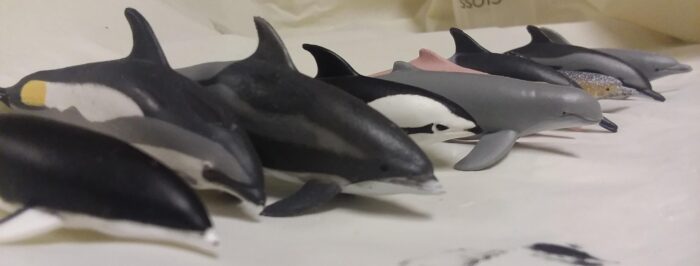
In 2019, Safari Ltd. released an oceanic dolphin TOOB of 10 species. This release is very significant to cetacean collectors, because the dolphin family has a very narrow species-level representation in the toy industry due to the dominance of the killer whale and bottlenose dolphin. This TOOB should also be of interest for collectors of megafauna in the 1:30-1:40 scale, as this is where most of these figures fit the best.

Let’s begin with the Delphininae subfamily. This group represents the species that embody the archetypal likeness of dolphins with long beaks. Half of this TOOB is composed of this subfamily, spanning 4 different genera. Despite being technically feasible, this TOOB avoids making each species a different repaint of the same sculpt.

Unknown to most people, there are actually multiple subspecies of bottlenose dolphins, with several proposed as separate species, but as of yet, only the Indo-Pacific species (Tursiops aduncus) has received full recognition. Here, what we have is the common species (T. truncatus). The sculpt is consistent with the animal’s anatomy and is quite distinct from the other members of this set. Unlike most of these figures, this one has an umbilical scar and genital slit, indicating this as a male. This figure measures 95 mm, placing this figure at the 1:19-1:41 scale for this species.

There’s a lot of variation for the coloration within this species, and the paintjob opts for a basic solid gray with a light underside. Nothing too ambitious, but nicely done. Overall this figure looks better than most of Safari’s Sea Life counterparts, despite being done at a smaller scale.

Next up is the common dolphin (Delphinus delphis). This species is the most abundant cetacean, with conservative global population estimates of at least 4-5 million. Despite the bottlenose dolphin being the most popular in modern media, the common dolphin is dubbed such due to being the most often depicted subject of classical art and literature. It used to be a convention to divide the common dolphin into a long-beaked and short-beaked species, but phylogenetic analyses revealed this to result in polyphyly. There are currently 4 proposed subspecies. We once again see a rather fine sculpt, appearing to align with the main subspecies found in the Atlantic and Pacific oceans. At 87mm, this figure fits within in the 1:20-1:31 scales.
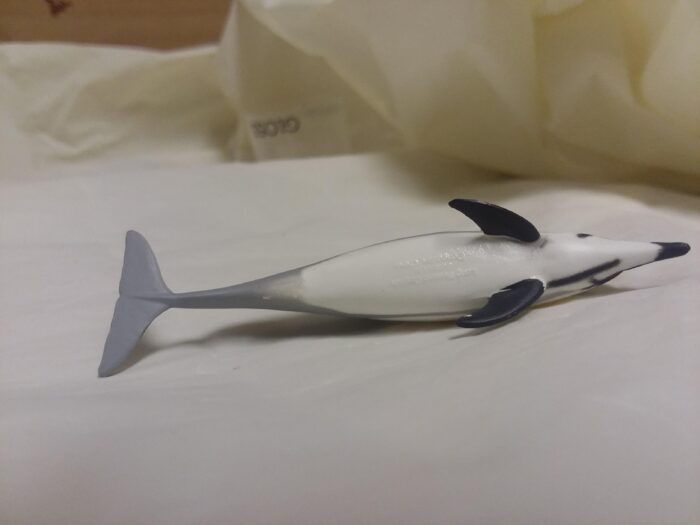
The paintjob fairly captures the strikingly complex coloration of the common dolphin species, though intraspecific variation prevents my scrutiny from being too precise. It should be noted that the imprinted label describes this figure as the long-beaked species, suggesting this may be the bairidii subspecies in the Eastern North Pacific.

Now we have the striped dolphin (Stenella coeruleoalba). Similar to the common dolphin, this species is very abundant across the world and was among the dolphins that were a major artistic subject of the Ancient Greeks. Stenella is currently a polyphyletic genus, with this species sharing a closer relationship with bottlenose and common dolphins than other species within Stenella. The sculpt is appropriately similar to common dolphins, but still has its own differences within the beak, dorsal fin, and tailstock. This figure is 86mm long, also fitting best at the 1:24-1:30 scales.
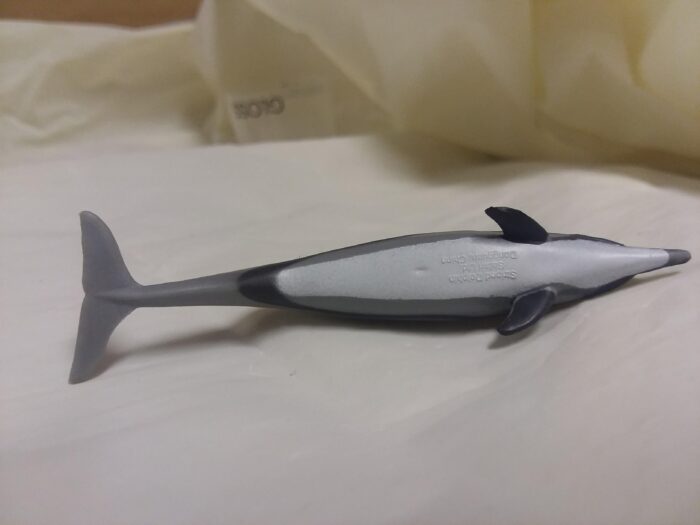
The paintjob appears to very appropriately capture the details of the major components of this species’ coloration. My only complaint is that below the main lateral stripe, the gray ought to form a lighter gradient with the white underside. Otherwise, this figure also checks out very well.
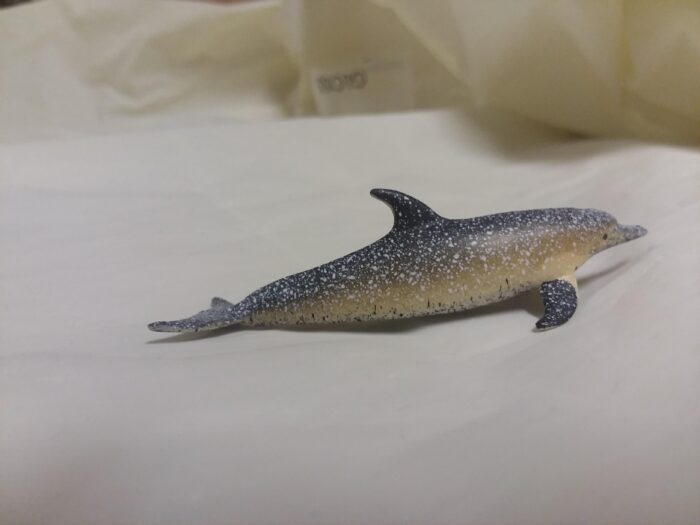
Here we have the Atlantic spotted dolphin (Stenella frontalis), one of the closer relatives of the striped dolphin. This species was once associated with another spotted species, but that relationship is no longer supported. Within this species are two major forms: a larger, spotted form and a smaller, lightly-spotted form. This sculpt is impressively quite distinct from the rest in both shape and size. At 71mm, this figure roughly corresponds to the 1:24-1:32 scale.
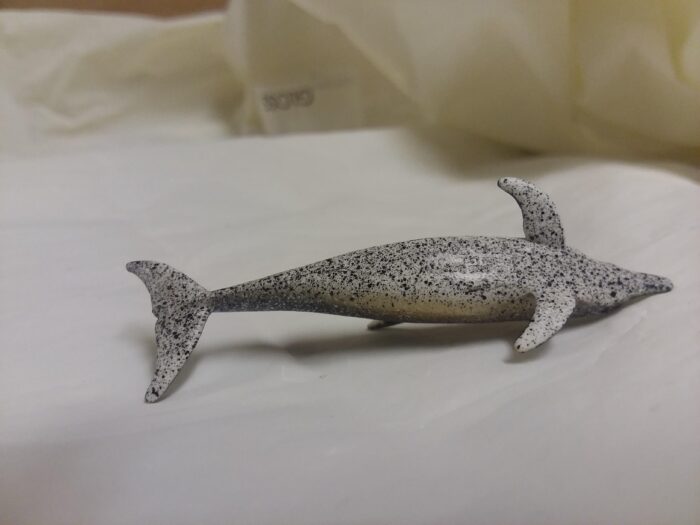
This paintjob is among the most detailed, but also the strangest one within this set. The figure is heavily speckled with both white and black dots with an underlying two-toned pattern for the main colors. However, in real life, the lighter tone along the sides of the body is a light gray. On this figure, it’s a tan/beige color, which isn’t normally seen even when accounting for intraspecific variation. Aside from this, there’s also too much mottling along with the flippers and flukes. While not bad looking, this is certainly the least accurate paint job within the entire set.

We currently reach the most basal member of the subfamily, the Indo-Pacific Humpback dolphin (Sousa chinensis). The taxonomy of humpback dolphins has been debated, but there are currently 4 recognized species with 1 tentatively proposed species in Bangladesh. This sculpt finely captures the appearance of this species and is quite distinct from the rest. At 83mm, this figure is within the 1:24-1:33 scale.
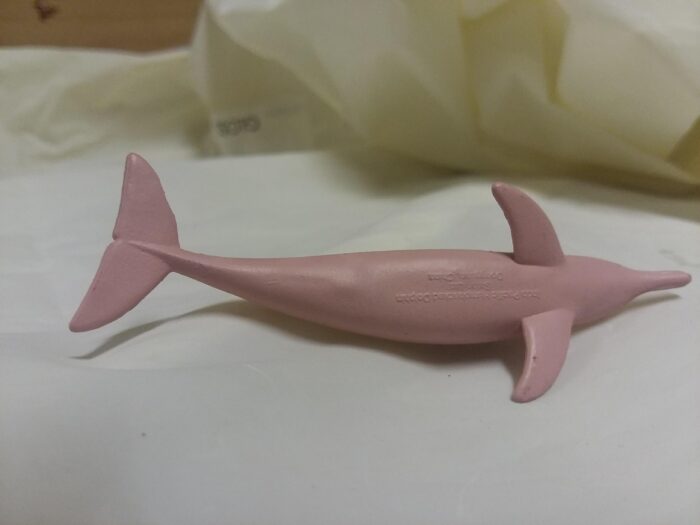
There is a fair degree of color variation within this species, possibly acting as the basis for identifying subspecies. Safari settles on a solid pink. Nothing too remarkable to regard about it besides not being too vibrant. A very fine job, especially as this species is not well-represented.
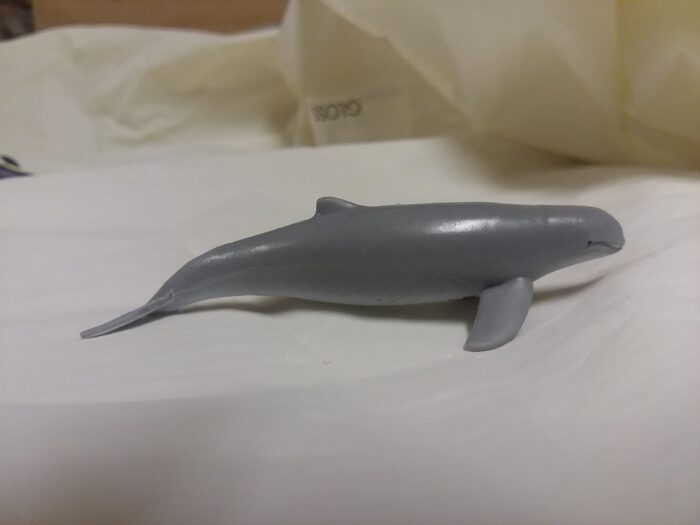
This set follows with a less typical-looking species, the Irrawaddy dolphin (Orcaella brevirostris). One of two species within this genus, this dolphin appears somewhat similar to the Indo-Pacific finless porpoise (Neophocaena phocaenoides). Mitochondrial genetic analyses initially supported a close relationship between this genus and killer whales, however, studies using nuclear DNA discredits this hypothesis. This genus, overall, shares more affinity with the Globicephalinae subfamily, which includes pilot whales and the Risso’s dolphin. The sculpt is quite accurate, I especially appreciate the placement of the dorsal fin and mouth sculpt. At 87mm, this figure fits in the 1:20-1:32 scale.
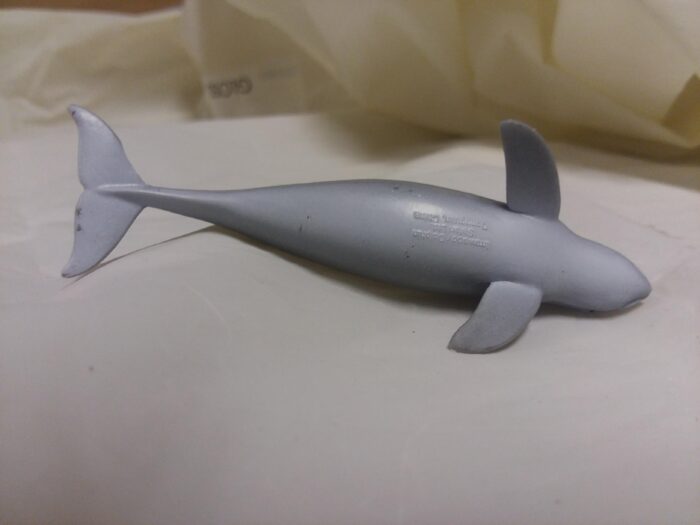
This species can vary somewhat in its main color from varying shades of gray. Here, a basic gray similar to the bottlenose dolphin is used, with a white underside. Overall, this figure is two-toned, which allows it to be distinguished from the three-toned Australian species. Nothing too daring, but it works very well for this species.
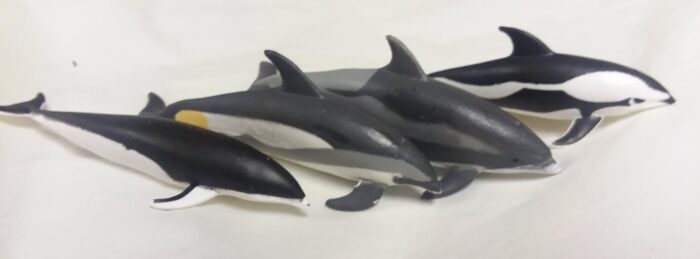
We now move on to the short-beaked group of dolphins. 3 of these species were once grouped as part of the Lagenorhynchus genus, which collapsed under the weight of modern molecular data and is now under heavy revision.

The white-beaked dolphin (Lagenorhynchus albirostris) was once the type species of a 6-species genus. Now molecular evidence shows this species is part of a lineage diverging just outside of the Lissodelphininae subfamily. The sculpt is pretty accurate, though the dorsal fin appears noticeably too small. The underside also features an umbilical scar. At 88mm, this figure aligns with the 1:27-1:36 scale.
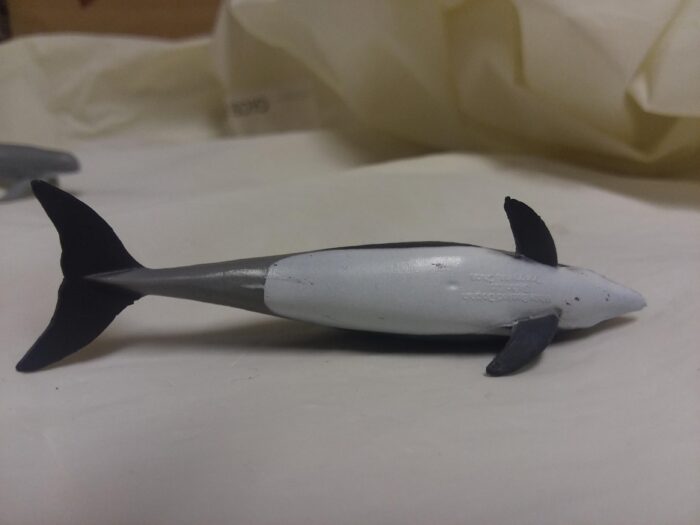
Once again, we’re seeing a species with a more complex coloration. When taking into consideration the variation within this species, this figure is a good approximation. My only complaint is that the dark stripes between the head and the pectoral fin should be lighter. Otherwise, there’s not much to criticize.
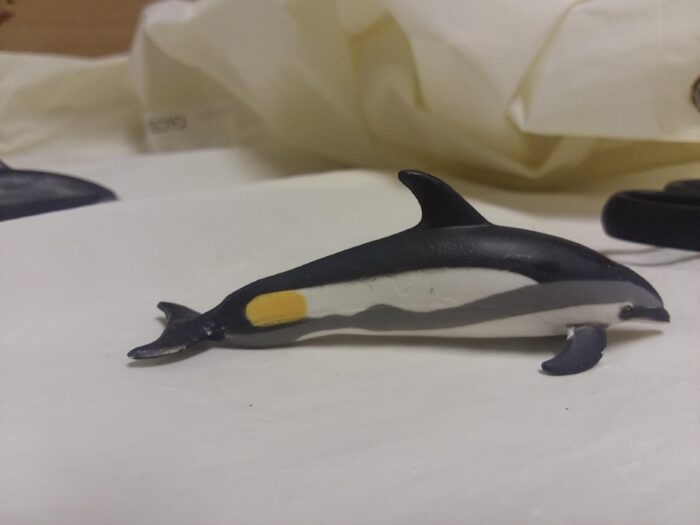
We approach the tail end with the Atlantic white-sided dolphin (Lagenorhynchus acutus). Authors currently propose to place this species in its own genus, Leucopleurus. Current phylogenies based on genetic evidence places this genus as being a basal lineage that diverged from the common ancestor of every other species of extant oceanic dolphins. The orca is the only exception, representing an even more basal lineage. Interestingly enough, this species was also added to Safari’s Sea Life lineup a year after this TOOB’s release. The sculpt captures a strong resemblance, especially the contours. There’s both an umbilical scar and genital slit on this figure, which is not present on its Sea Life counterpart. At 85mm, this figure fits in the 1:26-1:33 range for males of this species.

The paintjob is probably the most accurate of the species with complex colorations. My main criticism is that the yellow patch on the side of the tailstock should extend further, up to the posterior edge of the dorsal fin.

Our penultimate species is the hourglass dolphin (Sagmatias cruciger), another former member of the Lagenorhynchus genus. It is currently assigned within the Lissodelphininae subfamily as a sister genus of Cephalorhynchus. The sculpt matches the appearance of this species, though the dorsal fin appears to be too small. This is one of the figures that feature an umbilical scar. At 72mm, this figure works in the 1:22-1:26 scale.

The paintjob is very accurate to the animal with respect to how much the markings vary. There are no distracting nitpicks that come to mind.
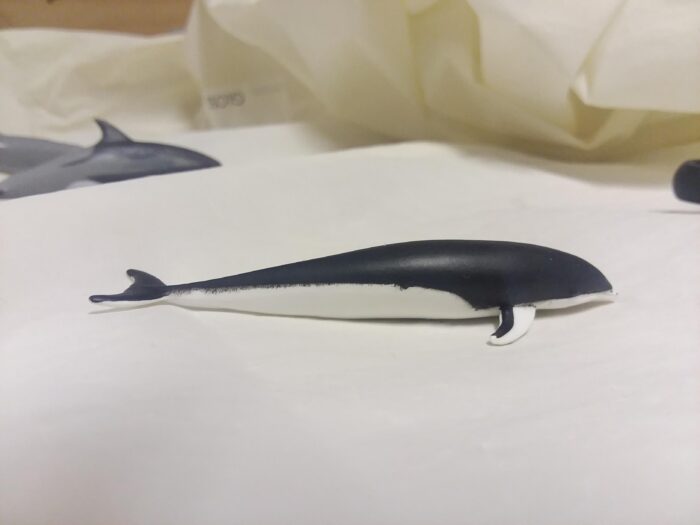
We end this review with both the strangest-looking and strangest-named species in this set, the southern right whale dolphin (Lissodelphis peronii). One of two species of right whale dolphins, this species is named due to both this genus and the right whale genus lacking any trace of their dorsal fins. This species shares the same subfamily as the Cephalorhynchus and Sagmatias genera. This species can be found in groups with normally hundreds of individuals, with upwards of 1000. The sculpt properly depicts the slim-nature of this animal. At 87mm, this figure falls within the 1:24-1:34 scale.

The figure sports a basic black-dorsal, white-ventral color scheme, just like the real animal. Not much to mention other than I appreciate the black stripe on the posterior edge of the pectoral fin.
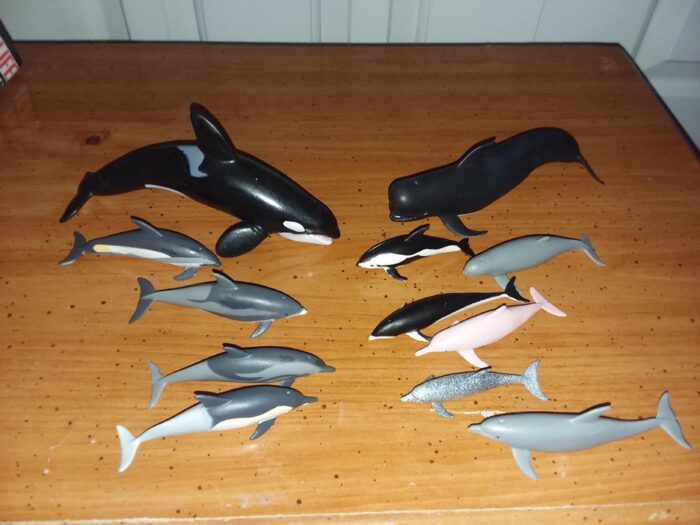
Overall, this set really is fantastic and accomplishes a lot at once. In one fell swoop, this set provides great taxonomic coverage of underrepresented groups of oceanic dolphins at a scale that’s conducive for owners of larger cetacean species and marine megafauna. Now, most of these figures ideally work best in the 1:30-1:35 scale, but they fail to appear excessively large even in my 1:40 scale collection. These figures are at just the right scale to be grouped with the Monterey Bay Aquarium killer whale and Seal Life pilot whale, allowing Safari Ltd. to boast a very broad scaled collection of oceanic dolphins. Customizers can also use these figures as templates for portraying closely-related species to those found here. This set comes with a high recommendation as a major convenience for sea life or 1:30-1:40 scale collectors.
Disclaimer: links to Ebay and Amazon on the AnimalToyBlog are affiliate links, so we make a small commission if you use them. Thanks for supporting us!



